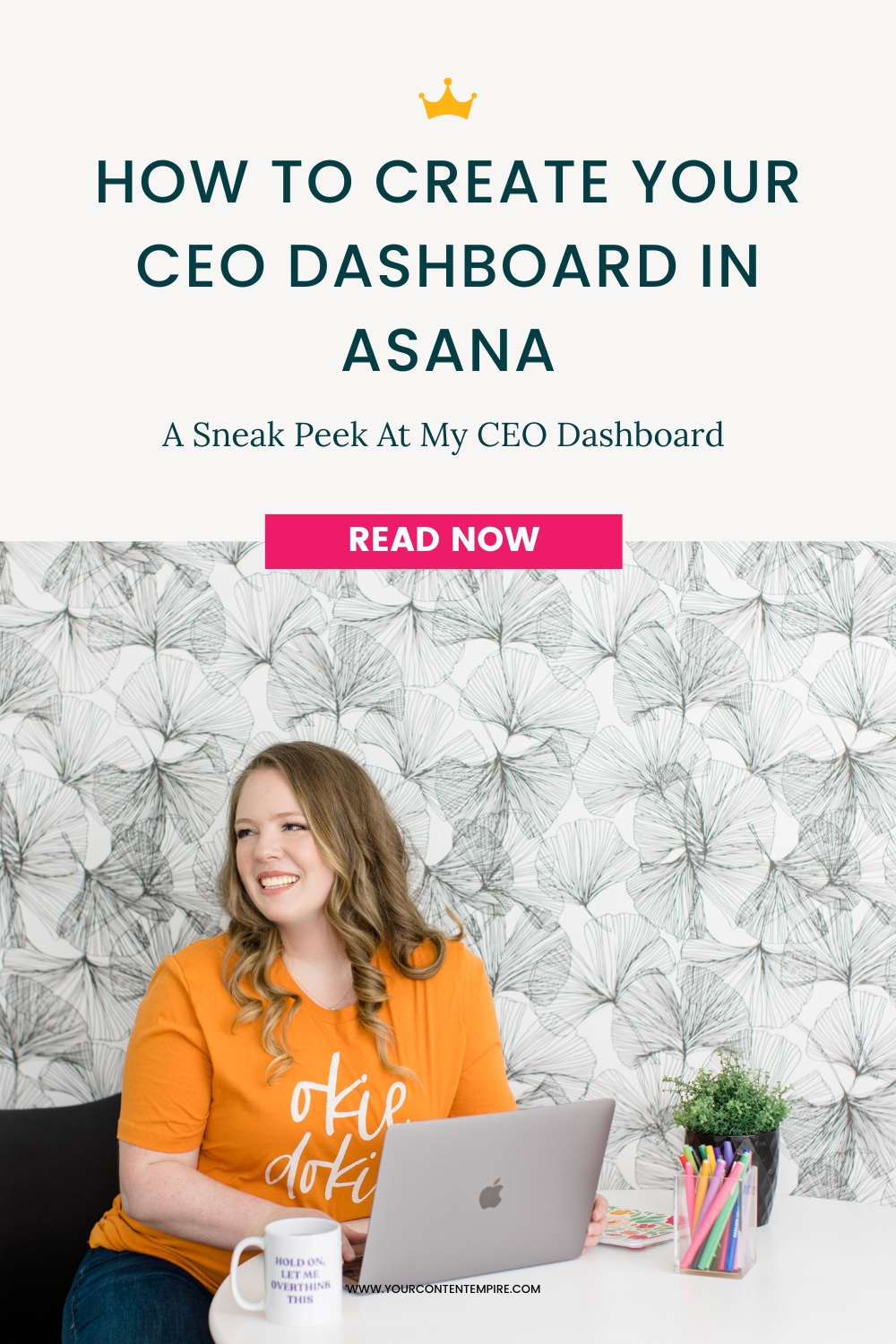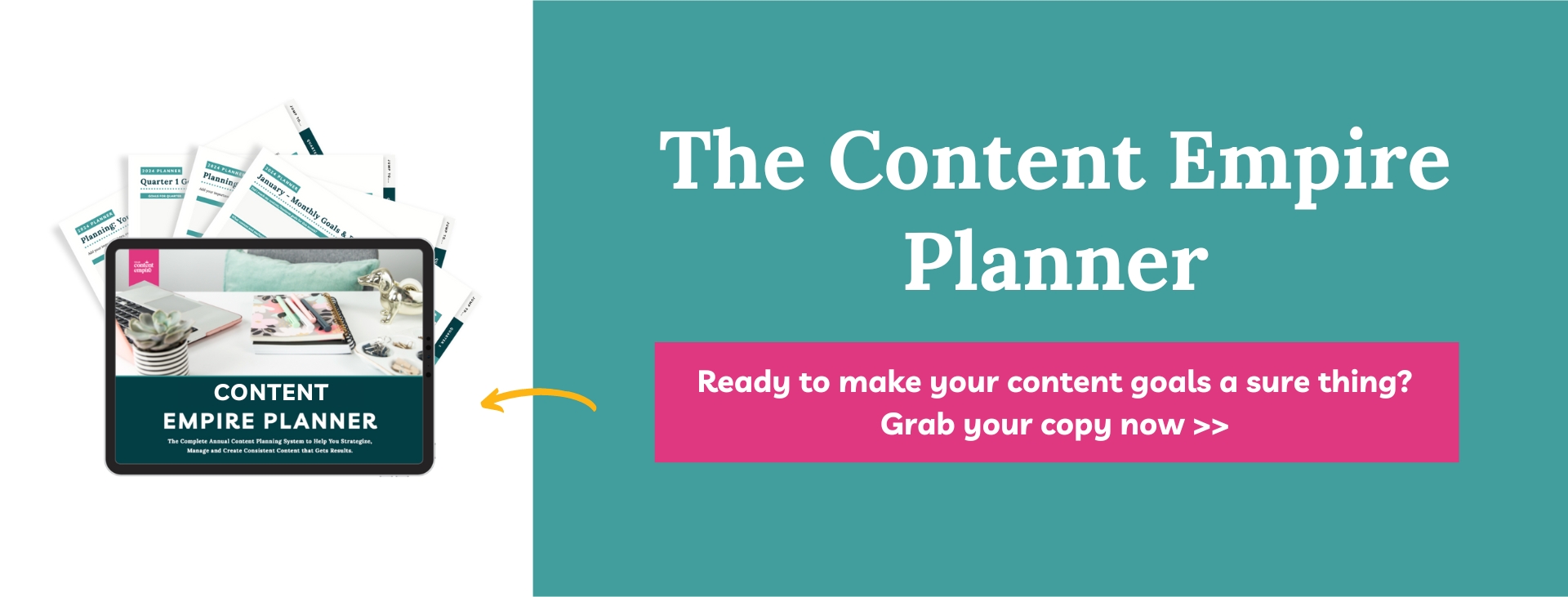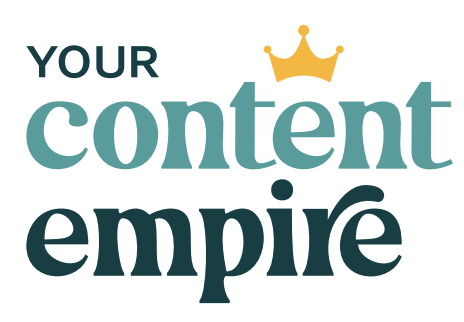In the post, I'm giving a sneak peek at my CEO Dashboard in Asana and walking you through how to set up your own.
Did you start this year with the best of intentions, only to get swept up in the day-to-day operations and weeds? And maybe by the time you realized it, here we are already in the final stretch of the year and you haven't made the progress you wanted to yet on your goals—and let’s not even talk about your fallen-by-the-wayside content.
Prefer to watch instead?
Welcome to an overpopulated club that I was basically once the chair of. When I first start my business back in 2014, I came out with a BANG (if I do say so myself). I launched my course, grow my list to thousands and became a go-to for content and content systems—all within the first 12 months. And I hadn’t even gone full-time in my business yet.
I don’t say this to gloat, but rather to point out a downside of growing too quickly: My growing business was built on shaky shaky ground because I didn’t have the right processes in place to make steering my business in the direction I wanted to go a sure-thing. Pretty quickly I found myself working nights, evenings and weekends without a day off in sight and year two became a S-T-R- U-G-G-L-E.
The biggest thing missing was a way to keep my goals and priorities top of mind; something that would let me embrace my role as the CEO of my business and a tool to get me out of the weeds and into strategic-thinking mode (aka the only way to build an intentional business that gets you closer to your vision).
That's where this Asana dashboard system was born. It’s a visual reminder about what you’re working towards and how all the pieces of your business (like your projects, content and goals) fit together.
Because here’s a hard truth to swallow: Time working only counts if you're working on the right things.
In this post, you’ll discover all the steps to designing, building, and using your Asana Dashboard so you can set yourself up for success in 2023 by using your time, energy and resources more productively.
Step 1: Designing Your Asana Dashboard
Before you jump into building your dashboard, it’s really important to take a moment to think about the design of your dashboard first—the sections, the purpose, what the end result will look like. Just like you check a recipe before baking a batch of cookies, you're going to want to prep your dashboard ingredients before too.
In this instance, ingredients equal sections. You’ll want to choose what sections (aka columns) you want to include in your dashboard first. Here’s a look at what I include in mine:
Section/Column #1: Progress (Goals)
Start with a list of your goals and a space to add a status update to them.
Define which ones are project goals versus achievement goals. Project goals are usually binary: You reach them or you don’t. These include things like: writing a book, creating your course, setting up a sales funnel. They’re projects and have a set of action items attached to them.
Achievement goals are usually some form of target that you’ll need to track or measure to know if you’ve reached it. These goals include things like: make 100 sales of my course, or book 2 sales calls per month.
Things to include in this column/section: Name, category, quarter, link to relevant folders or resources, your vision for what success looks like, and a measurement link for your achievement goals.
Section/Column #2: Promotions
In this section, decide what you're promoting or selling for each month of the coming year.
Add in date ranges, and don’t forget to include your pre-launch campaign time.
Things to include: The promo name, your goal for the promo, the category, link to relevant folders or resources, and a high-level outline of your promo plan.
Section/Column #3: Projects
In section three, add in your big projects. These are usually determined by your goals.
Organize these projects quarterly either by creating sections or having different lists for each quarter. Use task cards to assign action items. This will hold you accountable for reviewing your progress on these projects in stand-up meetings (with your team or with yourself) so you can decide what to work on next.
Things to include: The project name, the related goal and category, the month or quarter you’ll be focusing on the project, as well as folders, resources, subtasks, and notes.
Section/Column #4: Publishing (Content)
In this section, add your content bundles (blog post, podcast or video topics).
Create your bundle template and duplicate this for each one. Here’s a look at what my content bundle template looks like:
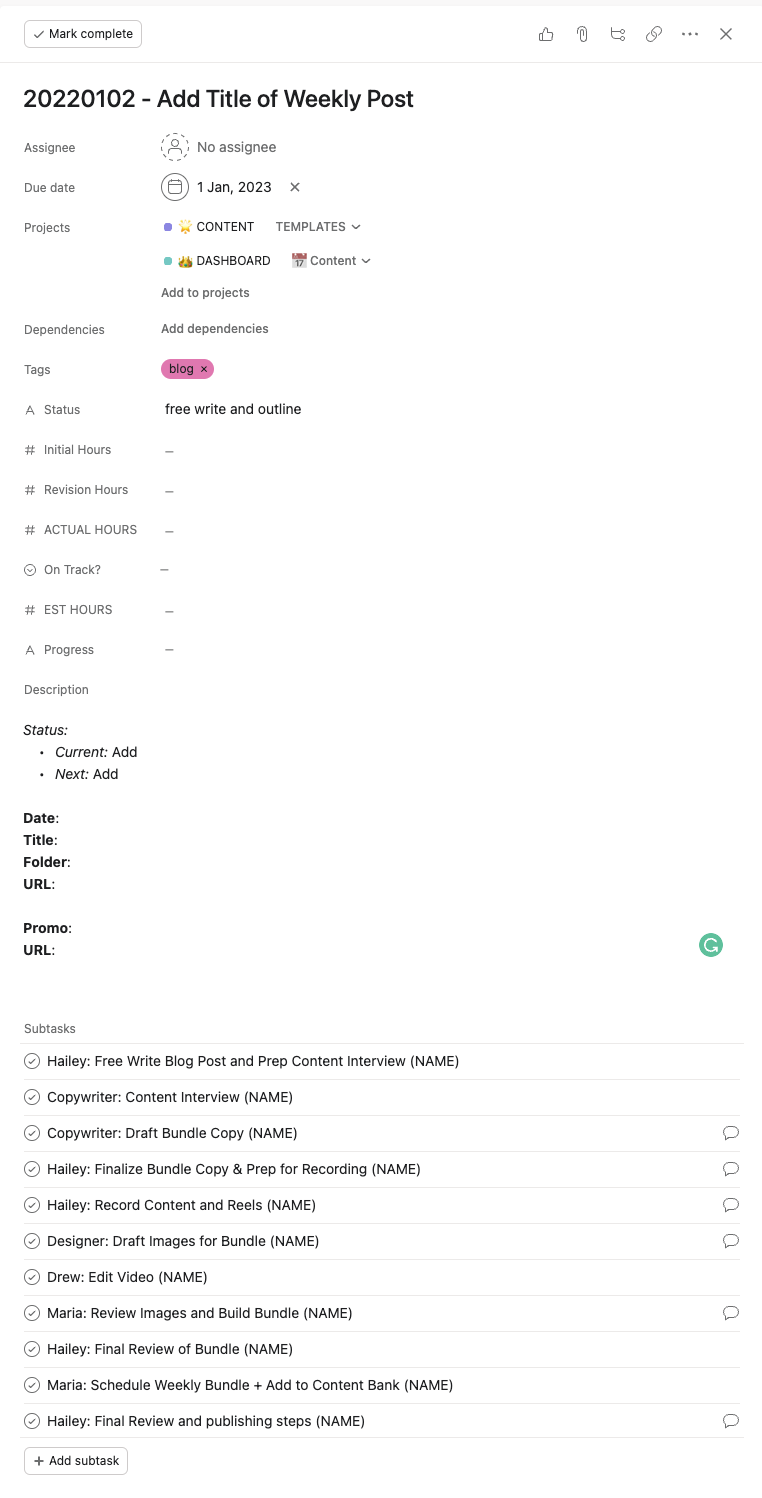
Things to include: The content topic, important links, the weekly promo or CTA, an outline, subtasks, and links to other related content and folders.
Section/Column #5: Processes
Add cards for your personal routines, processes and recurring meetings . Even though I like to have a separate ops manual for other parts of my business and offer delivery, I like to have a view of the strategic CEO routines I follow on a regular basis.
Here are some ideas of what processes you could include: CEO Friday Routine, Measurement Process, Content Planning Process, Team Meeting Agenda.
Things to include: Process name as well as relevant details and links.
Section/Column #6: People
In this section, set up different columns for your network and important people you want to remember to check in with or touch base with regularly. These might be: customers, clients, students, business besties, mentors, mentees, peers in your industry.
If you have a team, you could also include a section for them as well with details like – their roles, tasks, routines, links to folders and for assigning subtasks.
Step 2: Building Your Dashboard
Now's the fun part (depending on what you're into) where you get to create the dashboard and see it in action. If you’ve taken your time in designing your dashboard, setting it up is actually quite simple and straightforward.
Set-Up Your Board
Start by opening up a new project in Asana, and add a name (I like to add an emoji so I can easily find it in the sidebar). Then add it to your favourites, and choose kanban board as your project type.
Set Up Your Columns
Create a column for each of your sections you outlined in the previous step of designing your dashboard. For example, my columns are: Annual Goals, Quarter 1-4, Content, Processes, Team Members, and Clients.
Add Your Plans to Your Board
It’s time to add your plans to your board. This entails adding cards to each column/section, including:
- Goals: Add your goals, details about them and progress so far.
- Quarters: Add your goals/projects.
- Content: Add your upcoming content bundles.
- Processes: Add your core and recurring processes daily, weekly, monthly, and quarterly.
- People: Add your people cards.
Tip: Create a template card for cards you'll be creating multiple times.
Here's an example of what my dashboard looks like:
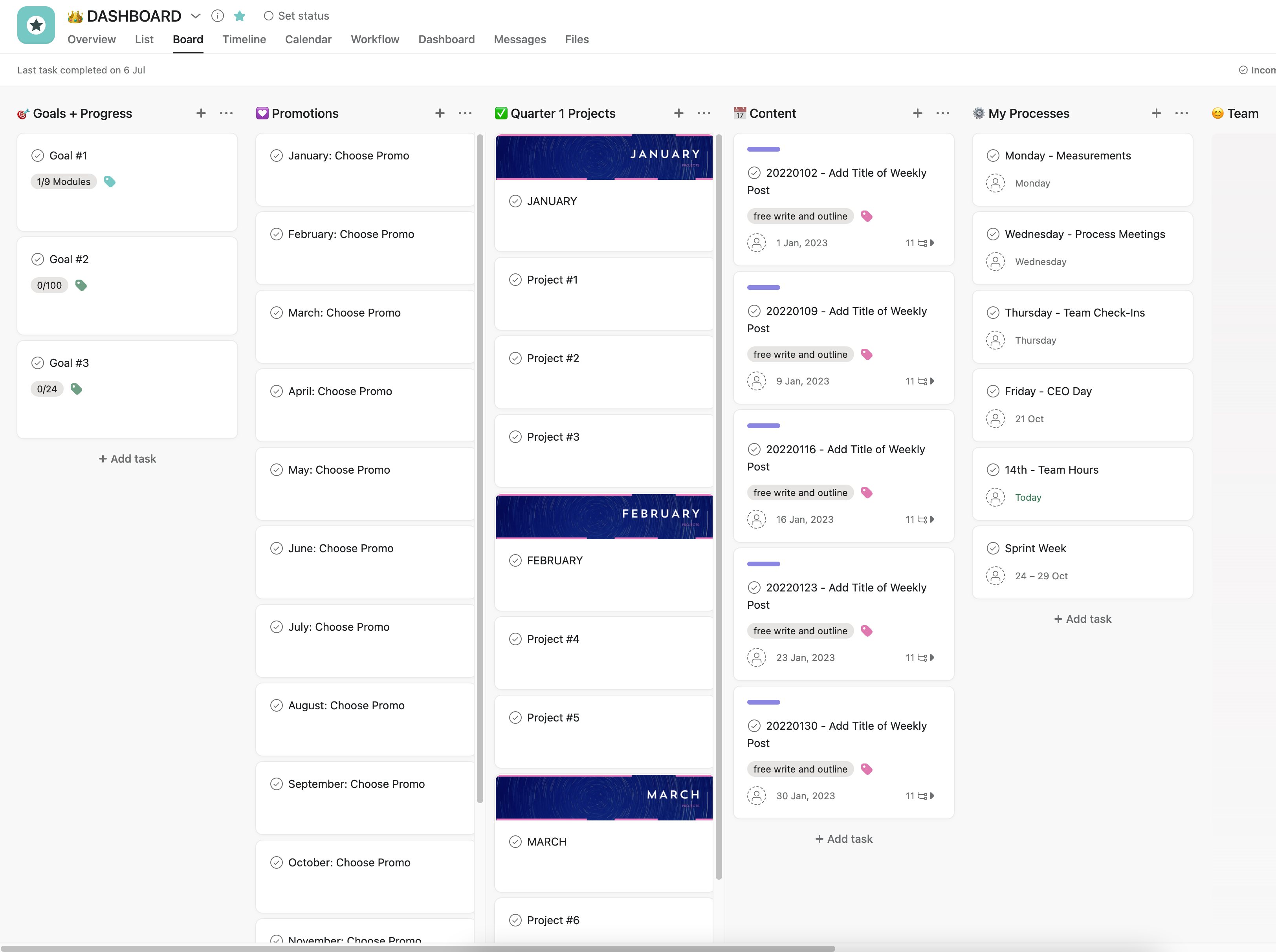
Add Any Extras
Lastly, if you have anything you're adding, add these in.
Step 3: Using Your Dashboard
Like any system, this is only going to make a difference in your business IF you actually use it. I've been guilty of creating complex systems or tools that I never end up using—only to have nothing more than wasted time to show for it.
Create a routine
Your routine is all about figuring out how you're going to use your CEO Dashboard to its fullest potential.
Here’s how I use it: At the beginning of each day when I sit down to work, I open it up and review it before fully jumping into my day. I identify the processes I need to be doing for that day, and then I get started and stay focused.
Keep Your Dashboard Updated
It’s important to go into your dashboard periodically and maintain it by keeping it updated. As you work through the year, a thing or two is bound to change. You might plan a solo retreat to reflect and tweak your plans, or you might lock yourself away and think about changing course in some way. Your dashboard isn’t to lock you into any particular plan but to make sure you’re being intentional when you do make changes.
No matter what happens, don’t let your dashboard get left behind!
Here’s how I keep mine updated:
- Weekly: I review my dashboard and update progress on my goals, content calendar and projects. I assign action items to my team for the coming week.
- Monthly: I review my board and add any projects or new content bundles to my board. I update my people column by adding any new connections.
- Quarterly: I do a big review of the board and create my new quarter column with projects and action items.
Are you ready to set up your own CEO Dashboard in Asana?
Designing your dashboard, setting it up, and actually using it is going to give you the structure you need to have a productive, goal-smashing 2023.
The key is intentionally setting it up to be just right for you, maintaining and updating it as the year goes on, and putting it to use.
And if you want my Asana CEO Dashboard template, grab it as part of the Content Empire Planner here ↓


